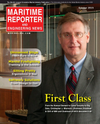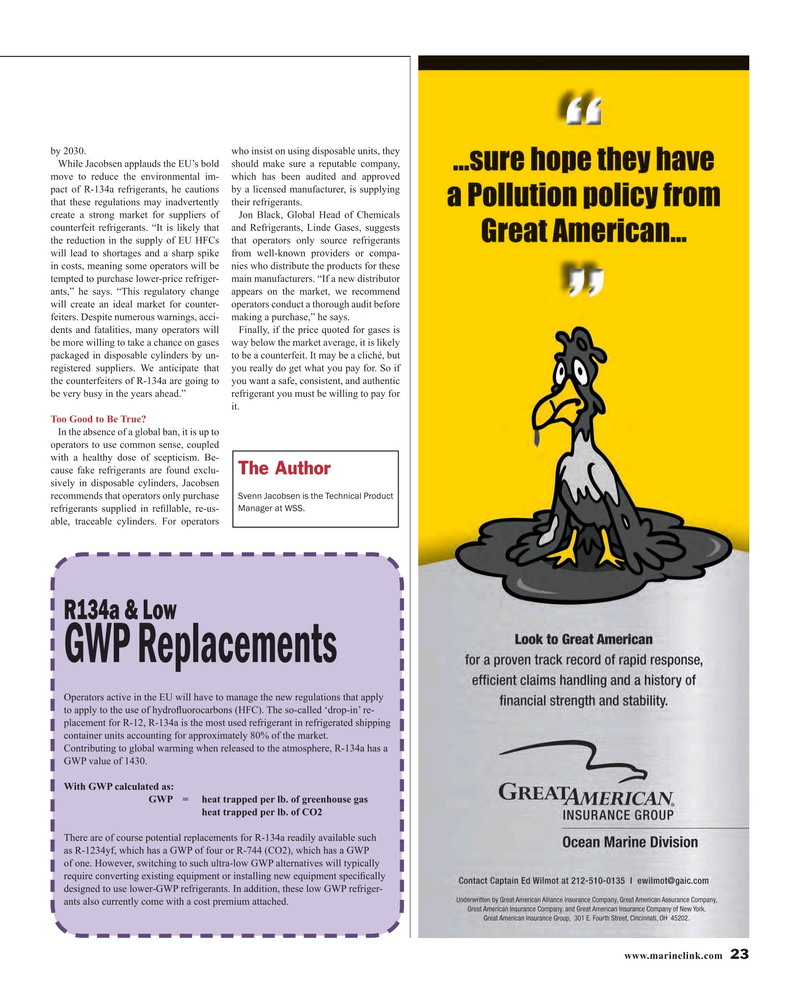
Page 23: of Maritime Reporter Magazine (October 2015)
Marine Design Annual
Read this page in Pdf, Flash or Html5 edition of October 2015 Maritime Reporter Magazine
by 2030. who insist on using disposable units, they
While Jacobsen applauds the EU’s bold should make sure a reputable company, move to reduce the environmental im- which has been audited and approved pact of R-134a refrigerants, he cautions by a licensed manufacturer, is supplying that these regulations may inadvertently their refrigerants. create a strong market for suppliers of Jon Black, Global Head of Chemicals counterfeit refrigerants. “It is likely that and Refrigerants, Linde Gases, suggests the reduction in the supply of EU HFCs that operators only source refrigerants will lead to shortages and a sharp spike from well-known providers or compa- in costs, meaning some operators will be nies who distribute the products for these tempted to purchase lower-price refriger- main manufacturers. “If a new distributor ants,” he says. “This regulatory change appears on the market, we recommend will create an ideal market for counter- operators conduct a thorough audit before feiters. Despite numerous warnings, acci- making a purchase,” he says. dents and fatalities, many operators will Finally, if the price quoted for gases is be more willing to take a chance on gases way below the market average, it is likely packaged in disposable cylinders by un- to be a counterfeit. It may be a cliché, but registered suppliers. We anticipate that you really do get what you pay for. So if the counterfeiters of R-134a are going to you want a safe, consistent, and authentic be very busy in the years ahead.” refrigerant you must be willing to pay for it.
Too Good to Be True?
In the absence of a global ban, it is up to operators to use common sense, coupled with a healthy dose of scepticism. Be- cause fake refrigerants are found exclu-
The Author sively in disposable cylinders, Jacobsen
Svenn Jacobsen is the Technical Product recommends that operators only purchase
Manager at WSS. refrigerants supplied in re? llable, re-us- able, traceable cylinders. For operators
R134a & Low
GWP Replacements
Operators active in the EU will have to manage the new regulations that apply to apply to the use of hydro? uorocarbons (HFC). The so-called ‘drop-in’ re- placement for R-12, R-134a is the most used refrigerant in refrigerated shipping container units accounting for approximately 80% of the market.
Contributing to global warming when released to the atmosphere, R-134a has a
GWP value of 1430.
With GWP calculated as: GWP = heat trapped per lb. of greenhouse gas heat trapped per lb. of CO2
There are of course potential replacements for R-134a readily available such as R-1234yf, which has a GWP of four or R-744 (CO2), which has a GWP of one. However, switching to such ultra-low GWP alternatives will typically require converting existing equipment or installing new equipment speci? cally designed to use lower-GWP refrigerants. In addition, these low GWP refriger- ants also currently come with a cost premium attached. www.marinelink.com 23
MR #10 (18-25).indd 23 10/5/2015 2:25:36 PM

 22
22

 24
24
